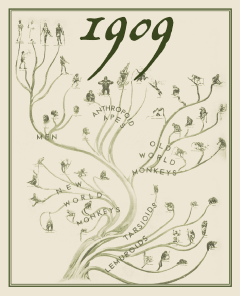 |
 |
Evolving in Public
Charles Darwin died April 19, 1882. However the impact and implications of his work continue to grow in the public's eye. Initially, Darwin had very little evidence to back up his theory, mostly observations about existing variations and a little fossil data about earlier forms that seemed related to present forms of life. Many scientists felt that selection was a good model for how evolution might work, but, still it did not explain many other questions about how life came to be. There was continued criticism that while these ideas were interesting they had not been tested and may not be testable because mechanisms of evolution were subtle and hard to show. In the mid-1800s quarrying and industrial mining were discovering large numbers of fossils throughout Europe. In America, the railroads and the opening of the West led to explorers and collectors finding the great fossil fields of the Dakotas and Arizona. Literally tons of fossils were being shipped to museums to be puzzled over and displayed. Museums at the turn of the 20th century were regarded as the poor man's university. As bones of ancient mammals begun to be displayed, curators would arrange them from most primitive to most modern. These displays of horses and other fossils became advertisements of and validation for modern forms of life arising from more primitive ancestors. Of particular interest and controversy were displays of primate fossils and early human fossils together leading to the implied conclusion that humans are related to these primates. Evolutionary ideas from Scientific Darwinism and Social Darwinism also began to be applied more broadly to speculations about the ultimate fate of man. Writings in popular books and journals discussed fears about the future of the species in general. | ||||
| ||||

 Click Image to Zoom
Click Image to Zoom


 There is grandeur, if you look at every organic being as the lineal successor of some other form...
There is grandeur, if you look at every organic being as the lineal successor of some other form...